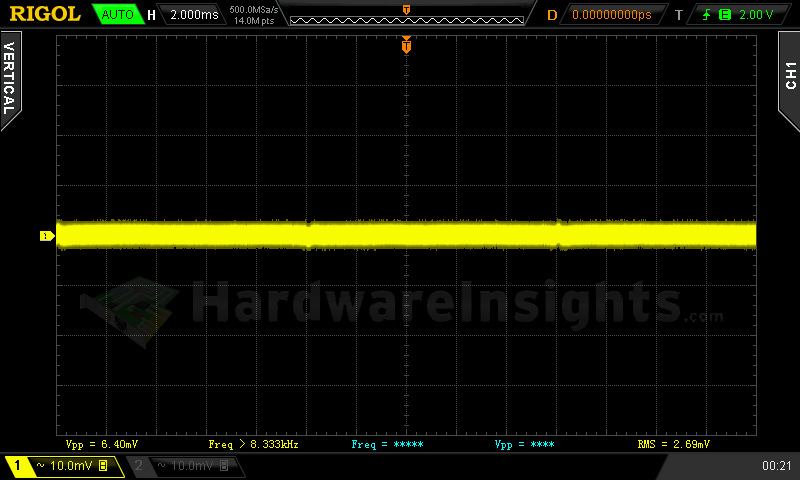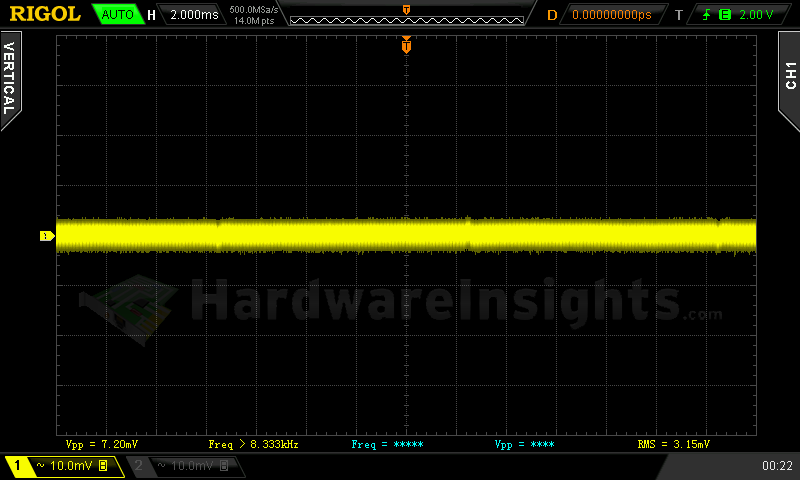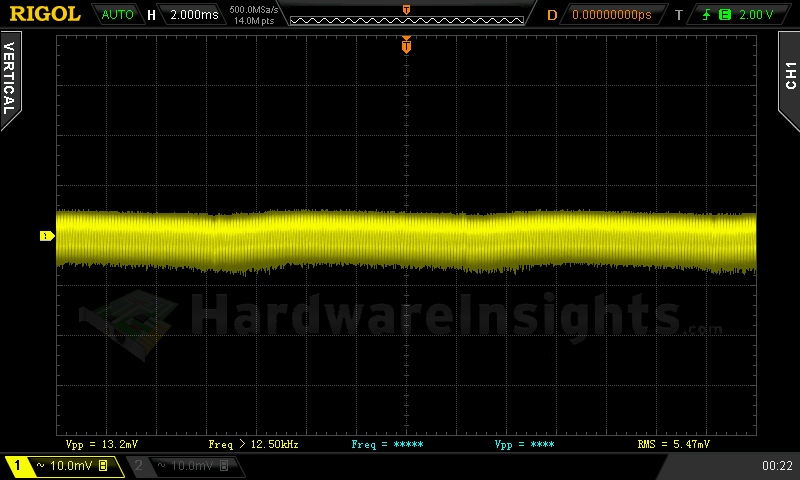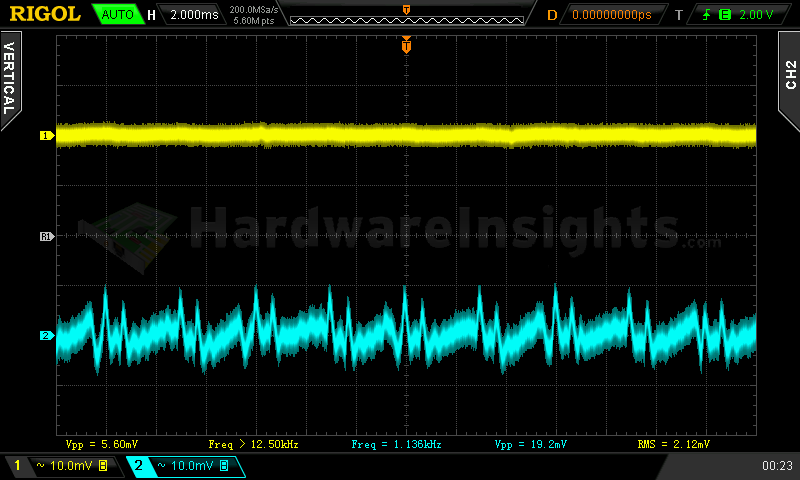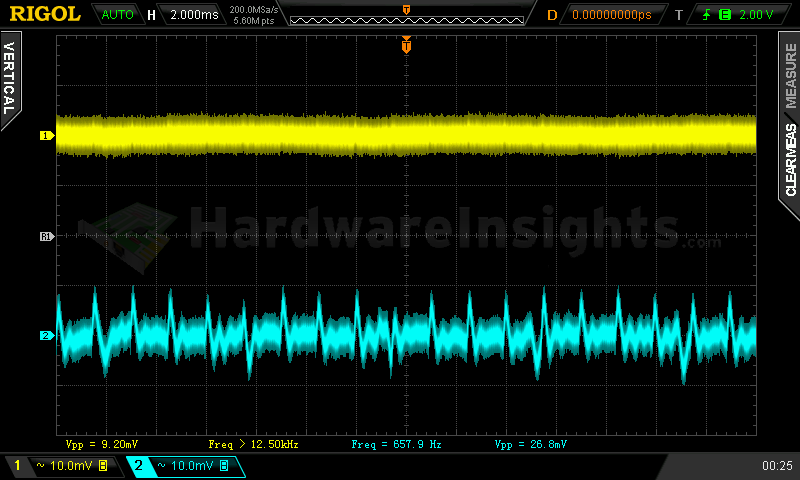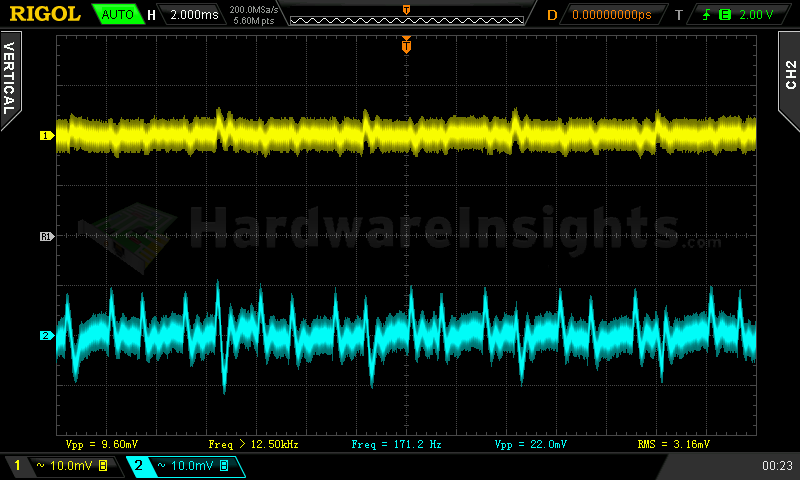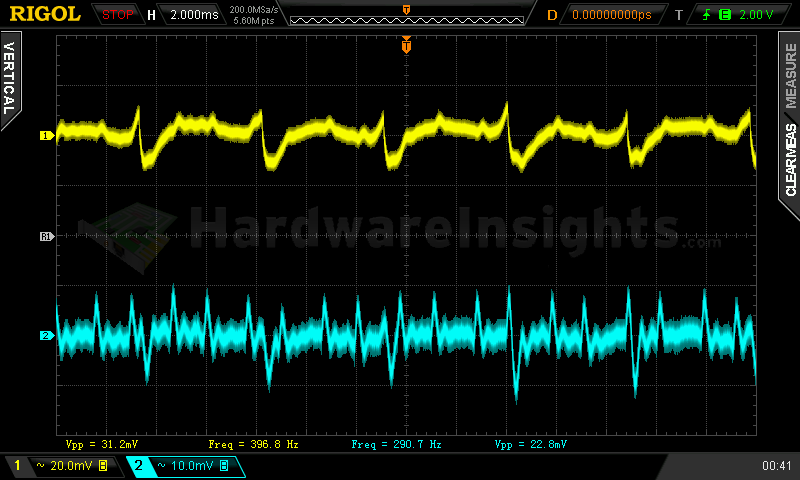Contents
- 1Introducing the Whitenergy ATX-350W
- 1.1Packaging and accessories
- 2Connectors & cabling
- 2.1Casing & cooling
- 3Input filtering
- 4Primary side
- 4.1+5 V stand-by rail
- 5Secondary side
- 5.1Build quality
- 6Load testing
- 6.1Loading +5 V SB
- 6.2Voltage hold-up time
- 6.3Combined loading
- 6.4Combined loading ripple
- 6.5Crossloading, overloading
- 6.6Crossloading, overloading ripple
- 6.7Fan speed, temperatures and noise
- 7Conclusion and evaluation
- 7.1Discussion
Load testing
Loading +5 V SB
As always, all load testing is done according to our testing methodology. The voltage regulation is really poor. The unit was able to deliver rated power (only 1.5 A), however, under overloading of about 3.5 A nominal the voltage immediately dropped under 4.5 V and was still dropping by about 20 mV per second. Who knows how that would end. So it can really only deliver this small power.
| Output (W) | Load (A) | Voltage (V)/ ripple (mV) | Input (W) | Efficiency/power factor |
| 0 | 0 | 5.18/2.69 | 2.69 | —/0.402 |
| 7.88 | 1.56 | 5.05/3.15 | 13.92 | 56.6 %/0.572 |
| 13.44 | 3.04 | 4.42/5.47 | 26.75 | 50.2 %/0.612 |
The only good parameter was the ripple suppression. Efficiency was very poor and check out that no-load power consumption of almost 2.7 W! So it is clear the ATX-350W (05749) does not comply with EUC order 1275/2008 and it is illegal to sell it in the whole EU!
+5 V SB ripple (left to right): 0 A; 1.56 A; 3.04 A
Voltage hold-up time
There is no hold-up time measurement as the unit failed to provide nominal power output and exploded.
Combined loading
Combined loading was so terribly bad. All the voltages were high right from the beginning, +5 V rail went out of ATX specification though it later dropped with load applied. The efficiency was low, topping at just about 75 %, if the meter can be trusted as there is no PFC so the harmonic distortion must have been very high.
| Output power | Load/ voltage +5 V SB | Load/ voltage +3.3 V | Load/ voltage +5 V | Load/ voltage +12 V | Load/ voltage −12 V | Input power | Efficiency/ power factor |
| 8.9 %/ 31.14 W | 0 A/ 5.18 V | 0.011 A/ 3.43 V | 0.323 A/ 5.33 V | 1.914/ 12.50 V | 0.470 A/ −11.61 V | 51.06 W | 61.0 %/ 0.602 |
| 20 %/ 72.19 W | 0.545 A/ 5.13 V | 1.503 A/ 3.42 V | 1.652 A/ 5.28 V | 4.01 A/ 12.47 V | 0.400 A/ −11.77 V | 99.99 W | 72.2 %/ 0.565 |
| 40 %/ 141.28 W | 0.539 A/ 5.13 V | 2.87 A/ 3.42 V | 5.06 A/ 5.21 V | 7.78 A/ 12.51 V | 0.412 A/ −12.17 V | 187.4 W | 75.4 %/ 0.537 |
| 60 %/ 210.25 W | 1.02 A/ 5.09 V | 4.07 A/ 3.41 V | 7.98 A/ 5.14 V | 11.58 A/ 12.50 V | 0.430 A/ −12.61 V | 283.0 W | 74.3 %/ 0.542 |
| 80 % | FAIL | FAIL | FAIL | FAIL | FAIL | FAIL | FAIL |
| 100 % | FAIL | FAIL | FAIL | FAIL | FAIL | FAIL | FAIL |
Under test four, when supplying about 260 W, two explosions occurred. First, one of the 13007’s exploded, followed by the fuse. The circuit breaker was tripped as well so all my devices on the same circuit were shut down…however, no carnage is visible inside, the transistor went out peacefully. Sometimes they tend to go all in flames and shrapnel.
Combined loading ripple
I must admit I am quite surprised how low the ripple was, it seems that at least some progress has been made in this area in the last decade. Maybe having earth grounding soldered directly to common of the secondary side helps a bit.
| Output % | Ripple +5 V SB | Ripple +3.3 V | Ripple +5 V | Ripple +12 V | Ripple −12 V |
| 8.9 | 5.60 mV | 9.20 mV | 9.60 mV | 22.8 mV | 31.2 mV |
| 20 | 6.40 mV | 8.40 mV | 10.0 mV | 21.2 mV | 34.4 mV |
| 40 | 4.80 mV | 7.20 mV | 13.6 mV | 23.6 mV | 30.8 mV |
| 60 | 5.60 mV | 5.20 mV | 9.60 mV | 27.8 mV | 42.0 mV |
| 80 | FAIL | FAIL | FAIL | FAIL | FAIL |
| 100 | FAIL | FAIL | FAIL | FAIL | FAIL |
Ripple 8.9% load (left to right): +5 V SB; +3.3 V; +5 V; −12 V. The second channel is connected to +12 V.
Crossloading, overloading
There is no crossloading nor overloading measurement as the unit failed to provide nominal power output and exploded. I can only note that the short-circuit protection is working at least for the +3.3, +5 and +12 V rails.
Crossloading, overloading ripple
No ripple measurement either.
Fan speed, temperatures and noise
Even though the fan in spinning on rather high RPM, it is not especially loud as it is just an 8cm one. As for the temperatures, the unit did not get very hot actually. Though I have the feeling while previous meter showed somewhat higher temperature, this one shows lower. I think there was slightly warmer than 12 °C though the unit once again got very cold air from opened window. I think I’ll check it with boiling water…
| Output % | Fan speed (RPM) | Temperature intake/ outtake | Noise (dBA) |
| 8.9 | 2347 | 12 °C/ 16 °C | 41.8 |
| 20 | 2386 | 13 °C/ 19 °C | 42.0 |
| 40 | 2384 | 13 °C/ 20 °C | 42.0 |
| 60 | 2390 | 14 °C/ 24 °C | 42.0 |
